
 In most cases, the focal point of every classic car restoration project was its engine. Vehicles produced during the Fifties and Sixties were exclusively powered by a conventional internal combustion engine.
In most cases, the focal point of every classic car restoration project was its engine. Vehicles produced during the Fifties and Sixties were exclusively powered by a conventional internal combustion engine.
Of the pieces that go to make up a classic car restoration jigsaw, the engine restoration can often be the most challenging and expensive. Depending on how the engine has been stored after it has been taken of the road, its way back to being once again driveable.
Although once the engine rebuild has been successfully completed it should reasonably be expected to provide many years of enjoyable
and problem free motoring pleasure for as well as a source of considerable pride.
Whether the restored classic is to be used exclusively for display, very occasionally driven to owner’s meetings and car shows or even used as a daily driver, it is the responsibility of the owner to make sure that the engine is being carefully maintained and functioning to its maximum.
I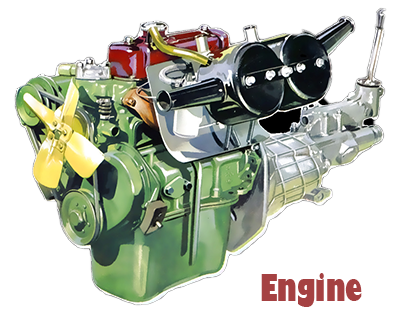 n its first phase of life, the typical lifespan of a classic car engine was around eight years or 150,000 miles. In recent years, advancements in technology, service standards, and design have led to an increase in the average life expectancy of vehicles. Currently, the average life expectancy of a new or fully recondition engine could be as high as 200,000 miles or approximately 10 years, if properly looked after.
n its first phase of life, the typical lifespan of a classic car engine was around eight years or 150,000 miles. In recent years, advancements in technology, service standards, and design have led to an increase in the average life expectancy of vehicles. Currently, the average life expectancy of a new or fully recondition engine could be as high as 200,000 miles or approximately 10 years, if properly looked after.
For the majority of classic car enthusiasts one of the principal attractions of owning a classic from the Fifties and Sixties was its manual gearbox.
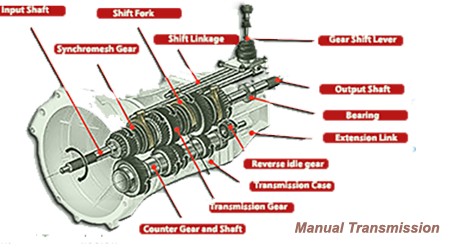 The majority of cars produced during the Fifties and Sixties were fitted with manual gear boxes.
The majority of cars produced during the Fifties and Sixties were fitted with manual gear boxes.
This situation continued well into the 21st century when automatic gearboxes gradually began to corner the market being less problematic and expensive. This development opened the door for classic car restorers to fit an automatic gearbox - easier to drive but a break from authenticity.
Making up the trio of major mechanical components for cars of the Fifties and Sixties was the clutch.
The role of the clutch in a classic car is to connect two or more rotating shafts; one coming from the engine and the other that turns the wheels. The clutch is one of the most important parts of the car’s working system as the engine is creating power all the time.
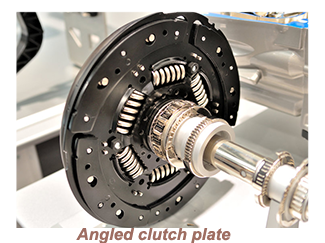 To change the speed of the car and stop it completely without turning off the’s engine, the connection between your engine and wheels needs to be interrupted temporarily. There are two major parts of the clutch: the clutch plate and the flywheel. There is a set of springs that pushes the pressure plate against the clutch plate when your foot is not pressing down the clutch pedal.
To change the speed of the car and stop it completely without turning off the’s engine, the connection between your engine and wheels needs to be interrupted temporarily. There are two major parts of the clutch: the clutch plate and the flywheel. There is a set of springs that pushes the pressure plate against the clutch plate when your foot is not pressing down the clutch pedal.
Clutches are one of the most useful devices in the mechanical systme , as a result of its two rotating shafts. One of them is driven by a pulley or a motor, whereas the other one drives another device. These two shafts are connected by the clutch so that they can spin together when locked or be unlocked and spin at different speeds. Flywheels and clutch plates.
 A classic car engine is connected to the flywheel whereas the clutch plate is connected to the transmission. As the driver presses down the pedal, the pressure plate is pushed against the clutch disc. This movement works against the flywheel. This mechanism allows the engine to spin at the same speed as earlier.
A classic car engine is connected to the flywheel whereas the clutch plate is connected to the transmission. As the driver presses down the pedal, the pressure plate is pushed against the clutch disc. This movement works against the flywheel. This mechanism allows the engine to spin at the same speed as earlier.
In an internal combustion engine, the combustion chamber is comprised of three main components: the cylinder, the piston, and the cylinder head. Specifically, the cylinder functions as the wall of the combustion chamber, while the top of the piston serves as the floor. Finally, the cylinder head is responsible for acting as the ceiling of the combustion chamber.
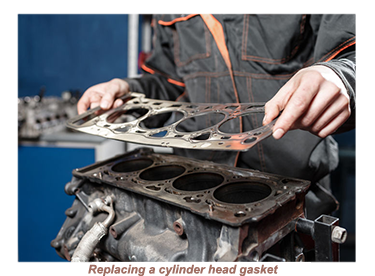 The cylinder head is responsible for housing several important components such as the intake and outtake valves, spark plugs, and fuel injectors.
The cylinder head is responsible for housing several important components such as the intake and outtake valves, spark plugs, and fuel injectors.
The pistons within an engine are responsible for reciprocating motion, moving in an up and down direction within the cylinder. The objects in question bear a resemblance to inverted cylindrical containers typically used for holding soup
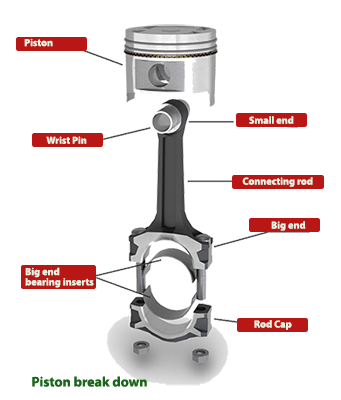 The crankshaft is a vital component of an internal combustion engine that transforms the linear motion of the pistons into a rotational motion, which is essential for the vehicle's propulsion.
The crankshaft is a vital component of an internal combustion engine that transforms the linear motion of the pistons into a rotational motion, which is essential for the vehicle's propulsion.
Spanning the entire length of the engine block, the crankshaft is located at the front end and is connected to rubber belts that transfer power to the camshaft and other components of the vehicle.
Meanwhile, the camshaft is located at the back end of the engine and is connected to the drive train, which is responsible for transferring power to the wheels.
Oil seals, also known as "O-rings," are located at both ends of the crankshaft to prevent oil leakage from the engine.
The camshaft is a critical component of an engine that controls the opening and closing of the engine's valves, which is essential for the engine's proper functioning. The engine's timing belt collaborates with the crankshaft to ensure that the intake and exhaust valves operate precisely at the appropriate moment, resulting in the best possible engine performance.
A crucial component of an engine's valve train system, camshafts utilise specially designed egg-shaped lobes positioned along its length to precisely control the timing of the opening and closing of the engine's valves, ensuring that the engine operates efficiently and effectively.Typically positioned in the upper section of the engine block, directly above the crankshaft. camshafts control the valves on one side of the engine, while the other camshaft controls the valves on the opposite side.
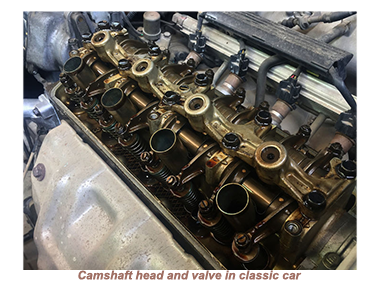 Synchronisation of the camshaft and crankshaft is achieved through the utilisation of a timing belt or chain. The timing chain is an essential component of an engine that ensures the synchronised movement of the crankshaft and camshaft. It maintains their relative position unchanged throughout the engine's operation. In case of a timing chain skip, the engine's camshaft and crankshaft will lose synchronisation, leading to engine malfunction.
Synchronisation of the camshaft and crankshaft is achieved through the utilisation of a timing belt or chain. The timing chain is an essential component of an engine that ensures the synchronised movement of the crankshaft and camshaft. It maintains their relative position unchanged throughout the engine's operation. In case of a timing chain skip, the engine's camshaft and crankshaft will lose synchronisation, leading to engine malfunction.
 The valvetrain is a crucial mechanical system that is affixed to the cylinder head and is responsible for regulating the functioning of the valves. A crucial component of an internal combustion engine, responsible for controlling the intake and exhaust of gases, the valvetrain comprises several parts, among them valves, rocker arms, pushrods, and lifters, which work together to regulate the flow of air and fuel into the engine and the expulsion of exhaust gases.
The valvetrain is a crucial mechanical system that is affixed to the cylinder head and is responsible for regulating the functioning of the valves. A crucial component of an internal combustion engine, responsible for controlling the intake and exhaust of gases, the valvetrain comprises several parts, among them valves, rocker arms, pushrods, and lifters, which work together to regulate the flow of air and fuel into the engine and the expulsion of exhaust gases.
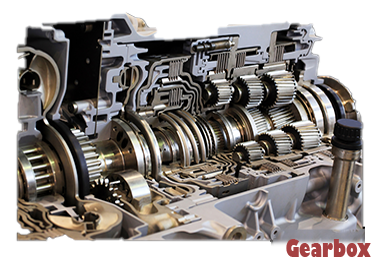 The valves are essential components of an engine's combustion system. Specifically, there are two types of valves that are responsible for regulating the flow of air and fuel into the engine and the exhaust gases out of the engine. These two types of valves are known as intake valves and exhaust valves, respectively.
The valves are essential components of an engine's combustion system. Specifically, there are two types of valves that are responsible for regulating the flow of air and fuel into the engine and the exhaust gases out of the engine. These two types of valves are known as intake valves and exhaust valves, respectively.
![]() Make sure to maintain a detailed maintenance log to allow tracking any parts replaced or repaired as well as regular service intervals. This will help you stay organised and identify patterns or issues that require attention.
Make sure to maintain a detailed maintenance log to allow tracking any parts replaced or repaired as well as regular service intervals. This will help you stay organised and identify patterns or issues that require attention.
Back to the homepage- and don't spare the horsepower.
me4


